Fluid Mechanics - GATE-CH Questions
Home -> GATE Questions with Solutions at MSubbu.Academy -> Fluid Mechanics->
Basics of Fluid Flow
GATE-CH-1988-2-iv-fm-1mark
For flow through a horizontal system, the ratio of exit pressure to inlet pressure is found to be greater than one.
GATE-CH-1989-2-i-b-fm-1mark
The condition that is not necessary for the applicability of Bernoulli equation is:
GATE-CH-1990-2-iii-fm-2mark
Bernoulli’s equation for steady frictionless flow states that, along a streamline:
GATE-CH-1999-1-9-fm-1mark
A pipe of I.D. 4 m is bifurcated into two pipes of I.D. 2 m each. If the average velocity of water flowing through the main pipe is 5 m/s, the average velocity through the bifurcated pipes is
GATE-CH-2000-2-10-fm-2mark
A free jet of water of cross-sectional area 0.01 m2 and a velocity of 20 m/s strikes a plate and then flows in the plane parallel to the plate as shown in the figure. The horizontal component of the force on the support is
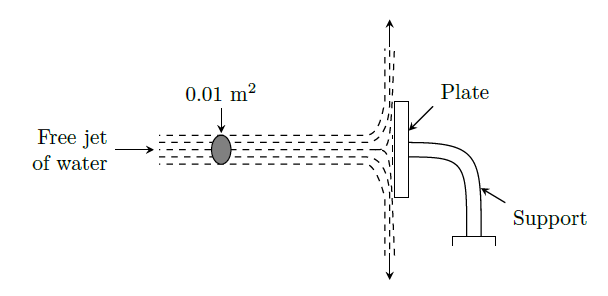
[Index]
GATE-CH-2014-49-fm-2mark
Match the following:
| Group-1 |
Group-2 |
| P. Turbulence |
I. Reciprocating pump |
| Q. NPSH |
II. Packed bed |
| R. Ergun equation |
III. Fluctuating velocity |
| S. Rotameter |
IV. Impeller |
| T. Power number |
V. Vena contracta |
GATE-CH-1999-10-fm-5mark
Derive an expression to obtain the time required to empty the vessel containing water as shown in the following figure. The cross sectional area of the opening at the bottom of the tank is \(a\). Assume \(H_o \ll H\).
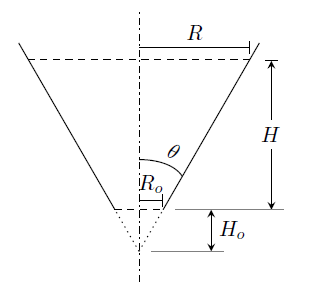
GATE-CH-0300-3-fm-4mark
A 1-cm wide space between two horizontal plane surfaces is filled with a lubricating oil of viscosity 0.03 N.s/m2.
(i) What force (in N) is required to drag a very thin plate of 2 m2 area through the oil at a velocity of 0.1 m/s if the plate is 0.3 cm from one surface? {#1}
(ii) What would be the force (in N) required, if the plate is placed midway between the surfaces? {#2}
GATE-CH-1992-13-a-fm-6mark
Water is forced into the device shown in figure below at the rate of 0.15 m\(^3\)/s through pipe \(A\), while oil of specific gravity 0.8 is forced in at the rate of 0.05 m\(^3\)/s through pipe \(B\). If the liquids are incompressible and form a homogeneous mixture of oil globules in water, what is the (i) average velocity, and (ii) density of the mixture leaving through pipe \(C\) having a diameter of \(\sqrt {7/22}\) m.
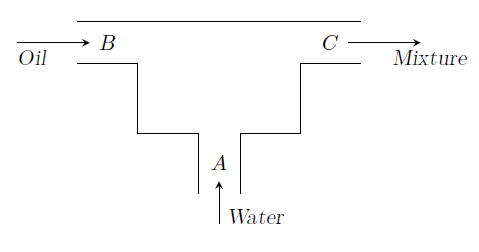
(i) {#1} (m/s)
(ii) {#2} (kg/m3)
GATE-CH-2008-78-79-fm-4mark
A siphon tube having a diameter of 2 cm draws water from a large open reservoir and discharges into the open atmosphere as shown in the figure. Assume incompressible fluid and neglect frictional losses. (\(g=9.8\) m/s2)
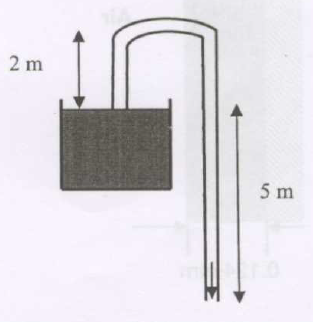
(i) The velocity (in m/s) at the discharge point is
{#1}
(ii) The volumetric flow rate (in L/s) of water at the discharge is
{#2}
[Index]
GATE-CH-2009-57-58-fm-4mark
A free jet of water is emerging from a nozzle (diameter 75 mm) attached to a pipe (diameter 225 mm) as shown below. The velocity of water at point A is 18 m/s. Neglect friction in the pipe and nozzle. Use \(g=9.81\) m/s2 and density of water = 1000 kg/m3.
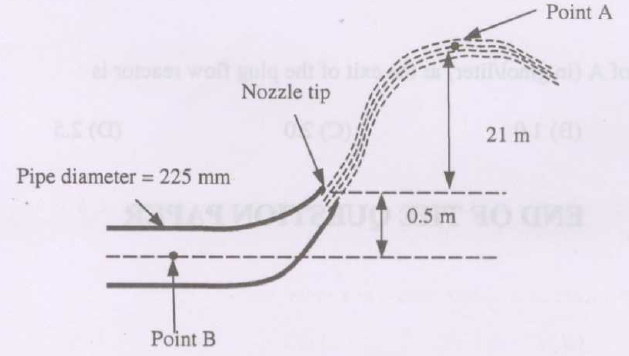
(i) The velocity of water at the tip of the nozzle (in m/s) is
{#1}
(ii) The gauge pressure (in kPa) at point B is
{#2}
GATE-CH-2003-50-fm-2mark
A pipe has a porous section of length \(L\) as shown in figure. Velocity at the start of this section is \(v_0\). If fluid leaks into the pipe through the porous section at a volumetric flow rate per unit area \(q(x/L)^2\), what will be the axial velocity in the pipe at any \(x\)? Assume incompressible one-dimensional flow i.e., no gradients in the radial direction.

GATE-CH-2007-35-fm-2mark
A pipeline system carries crude oil of density 800 kg/m3. The volumetric flow rate at point 1 is 0.28 m3/s. The cross sectional areas of the branches 1, 2 and 3 are 0.012, 0.008, 0.004 m2 respectively. All the three branches are in a horizontal plane and the friction is negligible. If the pressures at the points 1 and 3 are 270 kPa and 240 kPa respectively, then the pressure at point 2 is
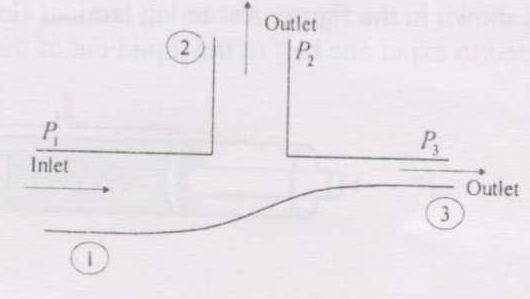
GATE-CH-2007-36-fm-2mark
The figure shows the idealized view of a return elbow or U bend, which is connected to two pipes by flexible hoses that transmit no force. Water with density 1000 kg/m3 flows at velocity of 10 m/s through the pipe, which has a uniform ID of 0.1 m. The gauge pressures at points 1 and 2 are 304 kPa and 253 kPa respectively. The horizontal force \(F\) required to keep the elbow in position is
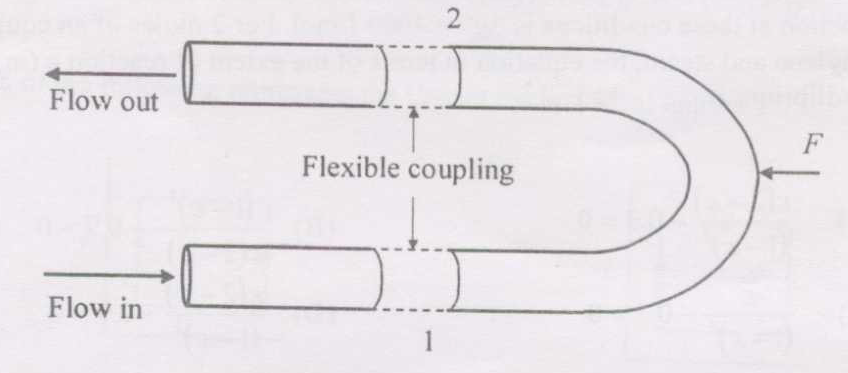
GATE-ME-2013-A-29-fm-2mark
Water is coming out from a tap and falls vertically downwards. At the tap opening, the stream diameter is 20 mm with uniform velocity of 2 m/s. Acceleration due to gravity is 9.81 m/s2. Assuming steady, inviscid flow, constant atmospheric pressure everywhere and neglecting curvature and surface tension effects, the diameter in mm of the stream 0.5 m below the tap is approximately
[Index]
GATE-ME-2018-S1-33-fm-2mark
A tank open at the top with a water level of 1 m, as shown in the figure, has a hole at a height of 0.5 m. A free jet leaves horizontally from the smooth hole. The distance \(X\) (in m) where the jet strikes the floor is
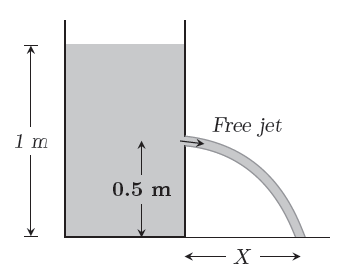
GATE-XE-2012-B-12-fm-2mark
Water is supplied to a tank at the rate of 0.02 m3/s, as shown in the figure below. The cross-sectional area of the tank is 1 m2 and the inner diameter of the outlet pipe is 60 mm. At a time when the water level in the tank is increasing at the rate of 5 mm/s, the average velocity (in m/s) of water in the outlet pipe is approximately
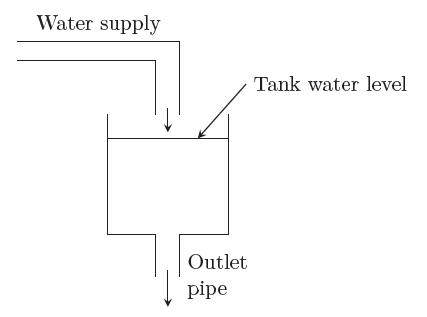
GATE-XE-2012-B-13-fm-2mark
The water level in a gas-pressurized tank with a large cross-sectional area is maintained constant as shown in the figure below. The water level in the tank is 4.2 m above the pipe centerline as indicated in the figure. The gas pressure is 130 kPa. The atmospheric pressure, gravitational acceleration and density of water may be taken as 100 kPa, 10 m/s2 and 1000 kg/m3, respectively. Neglecting losses, the maximum velocity (in m/s) of water at any location in the horizontal portion or the delivery pipe for the pressure NOT to drop below atmospheric pressure, is
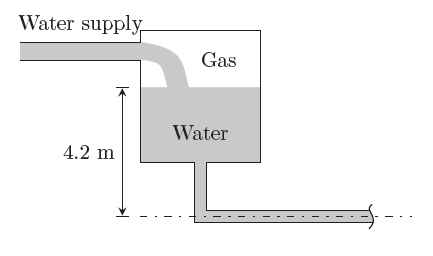
GATE-XE-2015-B-11-fm-2mark
Water drawing out into atmosphere from a small orifice located at the bottom of a large open tank. If the initial height of water column is \(H\), the time taken to empty the tank is proportional to
GATE-CH-1996-6-fm-5mark
A tank full of water is open at the top with a hole near the bottom, the area of which is 0.25 m2 and the cross-sectional area of the tank is 1 m2. If the height of the water above the hole is maintained at 10 m, what is the volumetric flow rate out of the hole? (in m3/s)
____________
[Index]
Last Modified on: 02-May-2024
Chemical Engineering Learning Resources - msubbu
e-mail: learn[AT]msubbu.academy
www.msubbu.in










